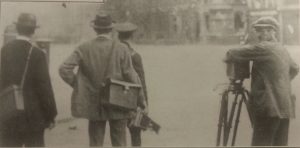Gordon Lewis, Pathé newsreel cameraman
Published in Issue 3 (May/June 2017), Letters, Volume 25 Sir,—It was with interest that I read Gavin Foster’s article about the IRA campaign against cinema during the Civil War (HI 25.2, March/April 2017). As someone who has been researching the role of newsreels and press photographers during the 1912–23 period, I am pleased to see some attention being paid to the often-forgotten role played by such media and how they were targeted in retaliation.
Sir,—It was with interest that I read Gavin Foster’s article about the IRA campaign against cinema during the Civil War (HI 25.2, March/April 2017). As someone who has been researching the role of newsreels and press photographers during the 1912–23 period, I am pleased to see some attention being paid to the often-forgotten role played by such media and how they were targeted in retaliation.
Gordon Lewis, a Belfast man who served as Pathé’s newsreel cameraman for many years in the Free State, is a particularly interesting example of the lives that some of those associated with the industry led during the Civil War. While the battle for Dublin was taking place, he positioned himself in the middle of Sackville Street to film and stepped away from his camera to adjust the focus. As he did so, a bullet blew the tripod out from under his camera. Later he was filming from a building opposite the ‘block’ where republicans had holed themselves up. Moving forward to get a better shot, he was spotted by a machine-gunner and was forced to throw himself to the floor to avoid a hail of gunfire; the resulting damage done to the window was filmed by him and used in the newsreel released subsequently. (See photo, above/below.)
Like the incidents related in Gavin Foster’s article, Lewis was also the subject of IRA intimidation. On 6 February 1923 his office in Lower Abbey Street was attacked, as reported in the press:
‘Four armed youths shut five girl clerks in a room and then sprinkled it with petrol and fired the premises. The girls managed to gain the street, but were badly burnt about the face and hands. The whole place was soon a furnace. There was then a violent explosion, injuring several other members of Pathé’s staff.’
The explosion destroyed a major archive of film dating back to 1912, as Lewis had just finished organising material from his personal collection to be donated to the nascent state archive, as well as a propaganda piece to be shown abroad called Ireland Today, which gave a film outline of the history of Ireland and the War of Independence. This was a substantial loss; Desmond Fitzgerald wrote later that year that there was still such a shortage of material that Lewis’s films of Michael Collins and Arthur Griffith could not be shown to mark the first anniversary of their deaths in August 1923 and cinemas had to make do with five still photographs.
Gavin Foster outlines the difficulties in staging the famous ‘Battling Siki’ fight, but Lewis had great trouble even getting there. Leaving Dublin on Sunday 4 March 1923 at 7.30pm, Lewis drove his Morris towards Tipperary but got lost near Cahir. Near midnight he came across a Free State military checkpoint, where he was detained. When the suspicious officer in charge asked where he had come from and Lewis replied ‘Cahir’, the puzzled officer asked why, then, was he on the road from Tipperary? After a long-winded explanation he was let go. It was now early morning but he continued on, having to make several detours in north Cork owing to blown bridges. Near Mitchelstown he was fired upon by occupying Irregulars, who tried to seize his car. Leaping a trench at nearly 40 miles an hour, he barely missed a stone wall erected to stop anyone driving past. Lewis eventually arrived in Cobh at 5am on Monday morning none the worse for wear, attributing his survival to luck and ‘strong headlights’! He eventually made it back to Dublin for the Siki fight on 17 March.—Yours etc.,
BEN FAGAN
















